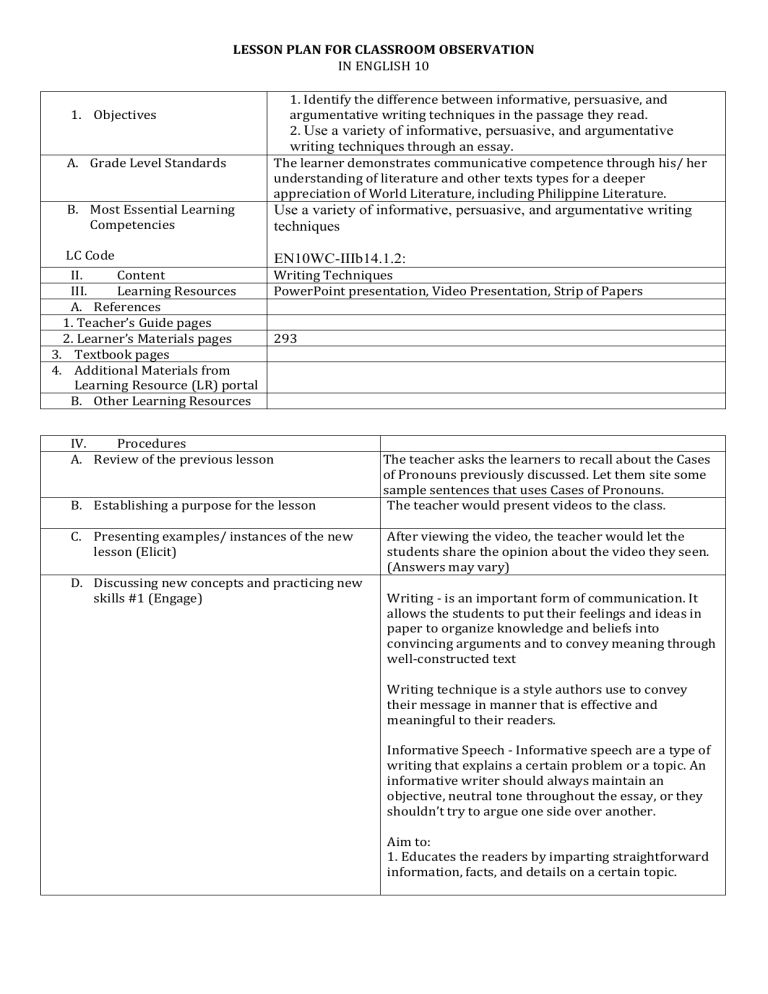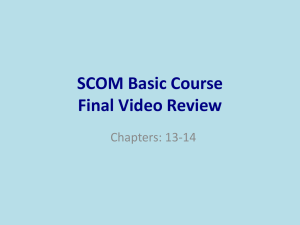
LESSON PLAN FOR CLASSROOM OBSERVATION IN ENGLISH 10 1. Objectives A. Grade Level Standards 1. Identify the difference between informative, persuasive, and argumentative writing techniques in the passage they read. 2. Use a variety of informative, persuasive, and argumentative writing techniques through an essay. The learner demonstrates communicative competence through his/ her understanding of literature and other texts types for a deeper appreciation of World Literature, including Philippine Literature. B. Most Essential Learning Competencies Use a variety of informative, persuasive, and argumentative writing techniques LC Code EN10WC-IIIb14.1.2: II. Content III. Learning Resources A. References 1. Teacher’s Guide pages 2. Learner’s Materials pages 3. Textbook pages 4. Additional Materials from Learning Resource (LR) portal B. Other Learning Resources Writing Techniques PowerPoint presentation, Video Presentation, Strip of Papers 293 IV. Procedures A. Review of the previous lesson B. Establishing a purpose for the lesson C. Presenting examples/ instances of the new lesson (Elicit) D. Discussing new concepts and practicing new skills #1 (Engage) The teacher asks the learners to recall about the Cases of Pronouns previously discussed. Let them site some sample sentences that uses Cases of Pronouns. The teacher would present videos to the class. After viewing the video, the teacher would let the students share the opinion about the video they seen. (Answers may vary) Writing - is an important form of communication. It allows the students to put their feelings and ideas in paper to organize knowledge and beliefs into convincing arguments and to convey meaning through well-constructed text Writing technique is a style authors use to convey their message in manner that is effective and meaningful to their readers. Informative Speech - Informative speech are a type of writing that explains a certain problem or a topic. An informative writer should always maintain an objective, neutral tone throughout the essay, or they shouldn’t try to argue one side over another. Aim to: 1. Educates the readers by imparting straightforward information, facts, and details on a certain topic. 2. Give them a new understanding or new appreciation of some topics which might be familiar with. 3. To answers questions of how and why. E. Discussing new concepts and practicing new skills #2 (Explore) 1. Developing mastery (Leads to Formative Assessment #3 (Explain) 2. Finding practical applications of concepts and skills in daily living (Elaborate) 3. Making generalization and abstractions about the lesson The teacher would let the students recall the lesson. 4. Evaluating learning (Evaluate) Learners will be given a summative test after the lesson. 5. Additional Activities for application or remediation (Extend) V. Remarks VI. The teacher would again use the videos presented in the beginning of the lesson. At this point the teacher would let the students identify the writing technique utilized in the video they viewed. The teacher would provide strip of papers that was cut from the magazine or newspaper that contains some articles. The students would be tasked to identify whether the article used Informative, Persuasive, or Argumentative Writing Technique. The learners would be given a performance tasked. They are going to create an advertisement or infomercial that uses different writing techniques. Reflection A. No. of learners who earned 80% in the evaluation B. No. of learners who require additional activities for remediation C. Did the remedial lessons work? No. of learners who have caught up with the lesson D. No. of learners who continue to require remediation E. Which of my teaching strategies worked well? Why did this work? F. What difficulties did I encounter that my principal or supervisor can help me solve? G. What innovation or localized materials did I use/discover which I wish to share with other teachers?

